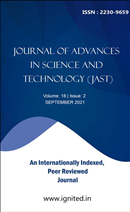Analyses of Seismic Structures and effect of Higher Modes on Residual Mode Method
Keywords:
Earthquake, Seismic Structure, Building Structures, Residual Mode MethodAbstract
In earthquake resistant design of building structures, priority is given to protection of human lives against infrequent but large earthquakes. Following the experiences of building performance from a large number of recent earthquakes all over the world, a lot of research is being carried out in this field. Based on the concept of saving human lives, in conventional seismic design, acceptable performance of a structure during earthquake ground shaking is linked to the lateral force resisting system being able to absorb and dissipate vibrational energy due to ground motions in a stable manner for a large number of cycles of motions. Energy dissipation generally occurs in specially detailed ductile plastic hinge regions of beams and column bases, which also form part of the gravity load carrying system. The proposed methodologies used and recommendations specified by seismic structure codes of training for the seismic analyses of structures, when high frequency modal responses are involved are reviewed. The effect of the damping ratio on the rigid response coefficient is studied for different earthquake ground motions.
Downloads
References
Gopen, P &Pankaj, A 2012, ‘Experimental Verification of Seismic Evaluation of RC Frame Building Designed as per previous IS Codes before and after Retrofitting by Using Steel Bracing’, Asian Journal of Civil Engineering (Building and Housing), vol. 13, no. 2, pp. 165-179
Guney, D & Kuruscu, AO 2011, ‘Optimization of the configuration of infill walls in order to increase seismic resistance of building structures’, International Journal of Physical sciences, vol. 6, no. 4, pp. 698-706.
Malu Girish & Murnal Pranesh, 2013, ‘Sliding isolation system: State of the art review’, International Journal of Mechanical and Civil engineeringISSN 2278-1684. vol. 02, no.6, pp. 30-35.
Mehmet, B & Tugrul, T 2011, ‘Experimental study on seismic strengthening of reinforced concrete Frames by precast concrete panels’, ACI Structural Journal, Title no. 108-S23, pp. 227-237.
Mehmet, I & Hayri, BO 2006, ‘Effect of Plastic Hinge Properties in Nonlinear Analysis of Reinforced Concrete Buildings, Engineering Structures, pp. 1494-1502,
Min KW, Hyoung-Seop Kim, Sang-Hyun Lee, Hongjin Kim, & Sang Kyung Ahn 2005, ‘Performance evaluation of tuned liquid column dampers for response control of a 76-story benchmark building’, Engineering Structures, vol. 27, pp. 1101–1112.
Mohammed Nauman, & Nazrul Islam 2014, ‘Behaviors of RCC multistoried structure with and without infill walls’, vol.3, no. 1, pp. 8455- 8465.
Moti Perets. 2014, ‘Literature Review & Survey of Spherical Bearing Patents’, International Journal of Scientific & Engineering Research, vol. 5, no. 7.
Mulgund, GV & Kulkurni, AB2011, ‘Seismic assessment of RC frame buildings with brick masonry infills’, International Journal of advanced engineering sciences and technologies, vol. 2, no. 2, pp. 140-147.
Murnal Pranesh & Sinha Ravi 2004, ‘Behavior of structures isolated using VFPI during near-source ground motions’, Proc. 13th World Conference on Earthquake Engineering, pp. 3105.
Murty, CVR & Das, D 2000, ‘Beneficial Effects of Brick Masonry In Fills In Seismic Design of RC Frame buildings’, Engineering Structures Journal, vol. 21, no. 4, pp. 617-627.
NEHRP 2009, Recommended Seismic Provisions FEMA-P 751 (2012), 450 National earthquake hazards reduction program.
Nikita Gupta, Dipali Sharma & Poonam 2014, ‘State Of Art Review-Base Isolation for Structures’, International Journal of Scientific & Engineering Research, vol. 5, no. 5. 225 36.NZS 1170
Nilupa Herath, Priyan Mendis, Tuan Ngo & Nicholas Haritos H 2010, ‘Seismic Performance of Super Tall Buildings’,Proceedings of International Conference on Sustainable Built Environment (ICSBE2010), Kandy.
Nitendra, GM & Raijiwala, DB 2011, ‘Seismic response control of a building installed with passive dampers’, International Journal of Advanced Engineering Technology, vol. 2, no. 3, pp. 246-256.
Nivedita, NR & Swati, DA 2013, ‘Pushover Analysis of Multistoried Building’, Global Journal of Researches in Engineering Civil and Structural Engineering, vol. 13,no.4, version 1.
NZS 1170.5:2004 Supplementary - Structural design actions Part 5: Earthquake actions - New Zealand.
Ohtori, Y, Christenson, RE & Spencer, BF 2004, ‘Benchmark Control Problems for Seismically Excited Nonlinear Buildings’, Journal of Engineering Mechanics, vol. 130, no.4, pp. 366-385.
OSHPD 1994, ‘Office of Statewide Health Planning and Development’, Division of Facility Development Structural Engineering Section.
Panchal, DR & Marathe, PM 2011, ‘Comparative Study of RCC, Steel and Composite (G+30 Storey) Building’, Proceedings of the International conference on current trends in technology - ‘NUiCONE – 2011’, Institute of technology, Nirma university, Ahmedabad.
Patil, S.J & Reddy, G.R. 2012, ‘State of art review-Base Isolation System for Structures’, International journal of emerging technology and advanced engineering, vol.2, no. 7.






